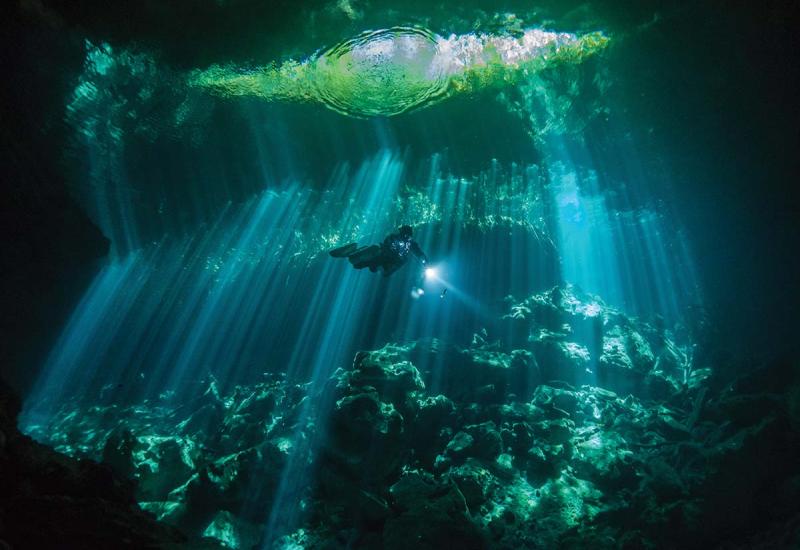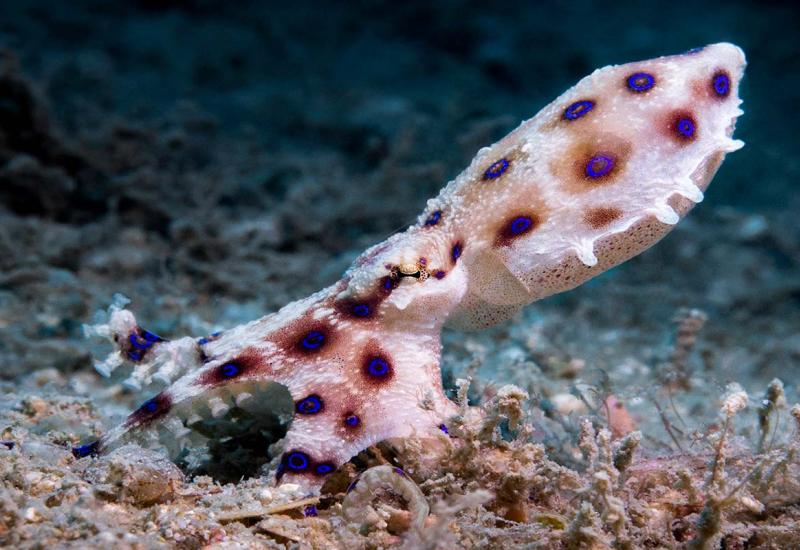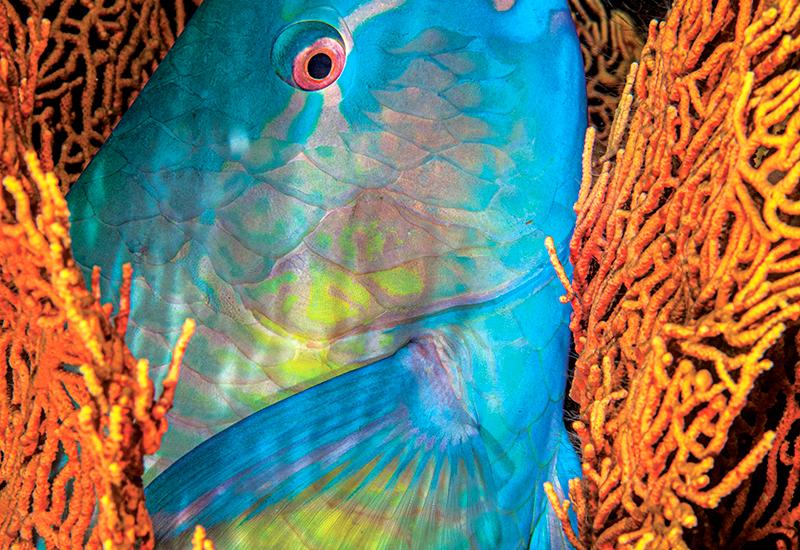Fantastic Voyage In the Andaman Sea
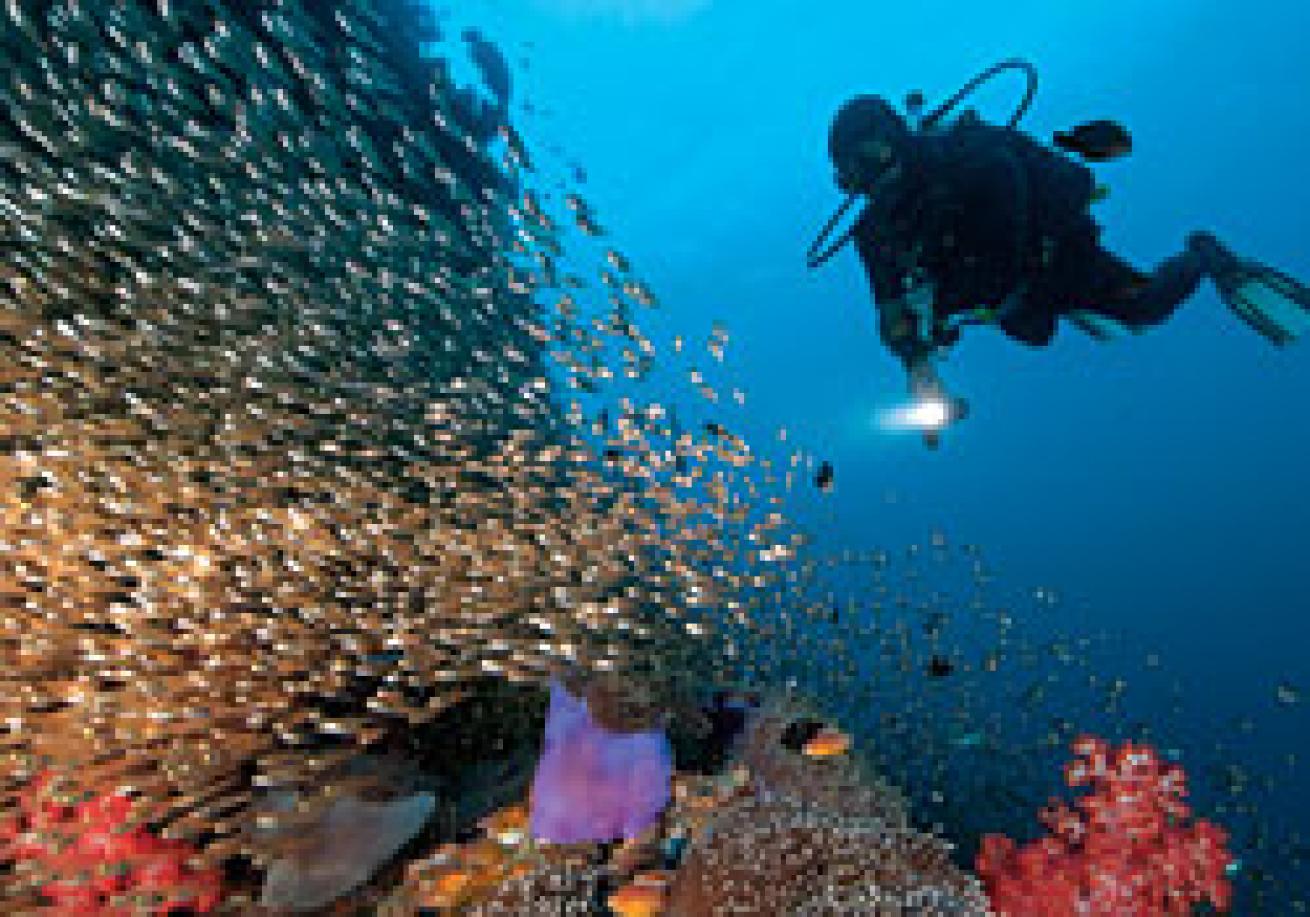
A burst of exploding firecrackers shatters the post-sunset tranquility. If we hadn't been briefed moments before, I might have jumped overboard in a panic. But, as was explained during the onboard briefing, it's a Thai tradition to light fireworks on the bow of a ship when leaving port. It is believed to ward off evil spirits for the ship's safe journey. As the smoke clears the bow, I survey the calm expanse of ocean. The hustle and bustle of Phuket fades away behind us, and we make good headway. After many hours of flying, it finally dawns on me that I have arrived in exotic Thailand. There's no better description than, simply, exotic. Both above and below the water, there are few places on earth that can rival Thailand's assortment of colors, textures, tastes and sounds. Even the sounds of the boats are different here: fishing boats and water taxis use simple, one-cylinder "eggbeaters," as they're sometimes called, that make a distinctive thwak, thwak, thwak sound. But as we make our way farther and farther from port, even the sounds of these engines fade away behind us.
On my last trip to Thailand's Andaman Sea, nearly two years ago, I explored the Similan Islands and points south. On this trip, the itinerary is taking us again through the Similans and north into Burma, or Myanmar as it is now known. On our way north we make a stop at Richelieu Rock, which, for me, is the highlight of the trip.
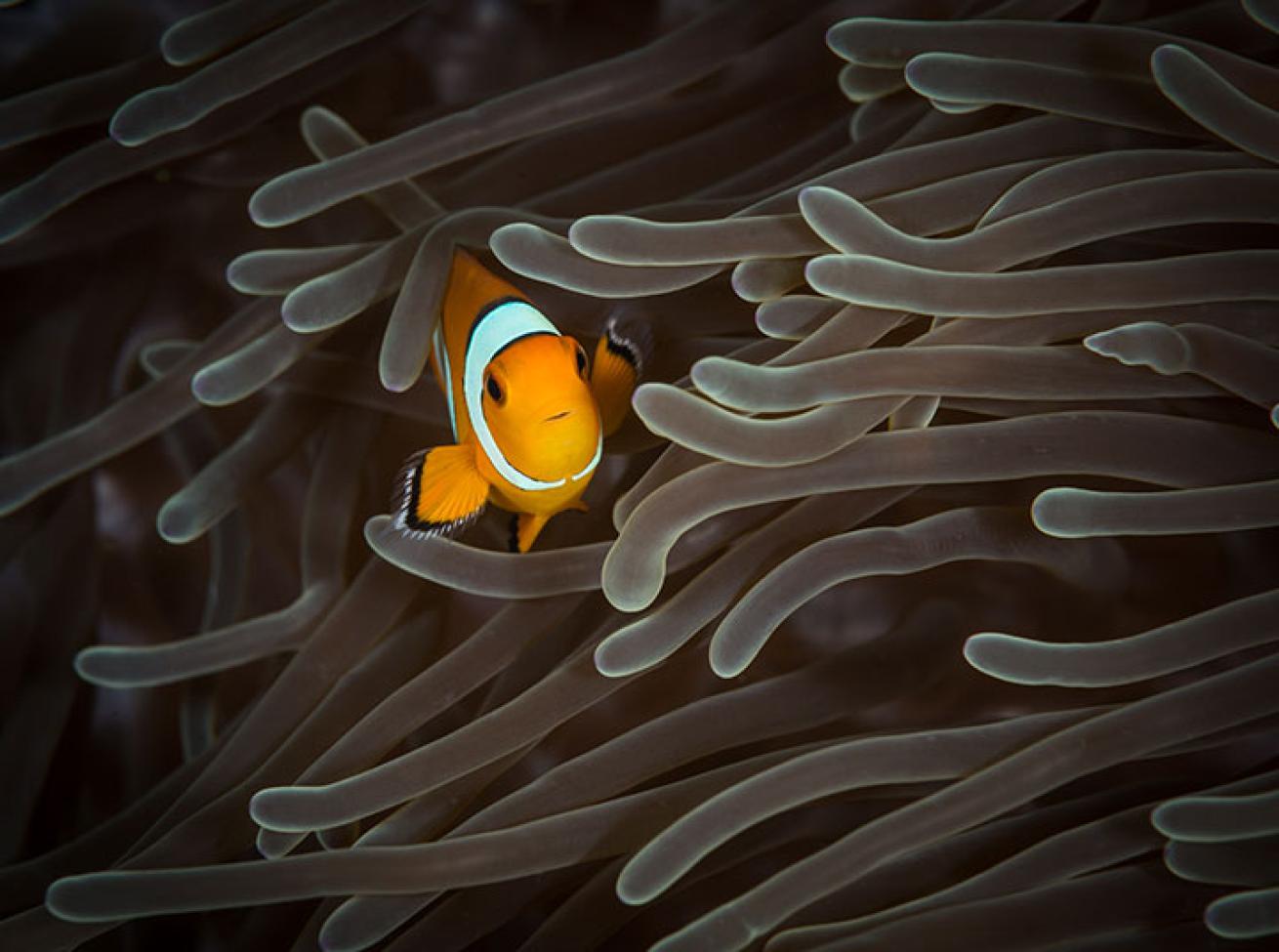
ShutterstockIn the wild, all anemonefish form symbiotic mutualism with sea anemones.
Shape-shifting Richelieu Rock
In the morning, we are greeted by the view of an otherwise barren sea, with the exception of a few small rocks that poke just above the surface of the water. Of course, these diminutive rocks belie the mammoth horseshoe-shaped pinnacle beneath the surface: Richelieu Rock. Situated between the Surin Islands and Thailand's mainland, the nearest real land is in the Surins, eight miles away. This enormous disruption on the ocean floor forces cool, nutrient-rich currents up the steep slopes of the rock, feeding the ecosystem that flourishes here. These plankton-rich waters are also known to attract whale sharks and mantas. Perhaps Thailand's most famous dive site, Richelieu Rock pays for its fame in the price of the many dive boats that frequent it. Despite the crowds that gather here, it's still one of the world's best dives.
I dived Richelieu Rock on my previous trip, but what I see on this trip blows away even my own memories of it. As we descend through unusually clear water, my eyes begin to play tricks on me. I stare at the rock, which appears to be amorphous, like a giant blob of Jell-O undulating in all directions. Having seen the rock before, I know that beneath this living skin there must be stone somewhere. As I near its surface, I discover a layer of silversides several feet thick covering the entire rock, top to bottom and extending in every direction. Coral cod, jacks and other predators make passes at the curtain of fish, causing gaps and holes to open up everywhere. Swimming into the mass itself, with no visual reference of anything that isn't moving, I feel a creeping sense of vertigo. The photographer in me imagines 1,001 ways to photograph this incredible sight.
After our morning dives, we sit down for a gourmet Thai lunch aboard our luxury live-aboard. Making conversation, I ask how everyone's dives went and am surprised when one woman answers honestly, "not so well."
"What was the matter?" I ask, thinking that maybe the slight current may have been too much for her. "The vis wasn't so good."
I am bewildered. The vis, in fact, was abnormally good for this site. Finally, she explains: "I couldn't see the coral because of all the fish in the way." The dining room goes silent. Silverware drops, and someone almost faints at another table. As if I am E.F. Hutton, everyone listens intently for my response. After all, it is the first time any of us has ever heard someone complain about an abundance of marine life. "Maybe we should ask the captain to take us somewhere a little less ... prolific?" I try my best to sound sincere. She nods in agreement. I receive icy stares from the other passengers.
Needless to say, everyone resumes eating, and, yes, diving despite the "bad vis." Although we don't encounter any whale sharks or mantas at Richelieu Rock, the schooling silversides provide (most of) us with unlimited entertainment. When tired of photographing the silversides, we spot ornate ghost pipefish, golden coral cowries, nudibranchs and a host of other exotic little creatures. In all, we spend two full days at Richelieu Rock. I could easily spend even more time here, but at the end of the second day, we pull anchor and head north into Myanmar's waters.
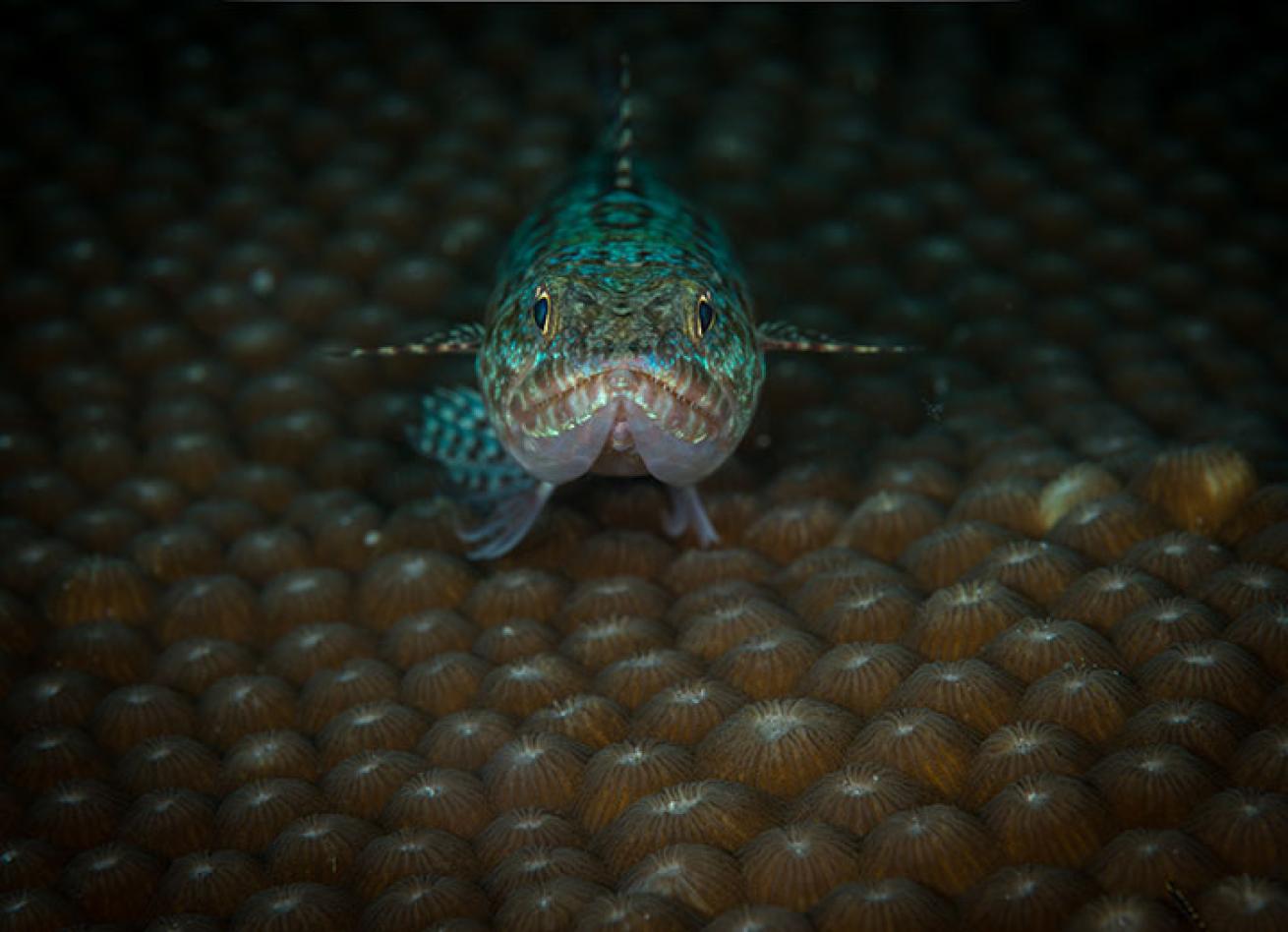
ShutterstockWith heads that resemble lizards, these fish are aptly named. They are generally small, and have mouths full of sharp teeth, even on the tongue.
On to Myanmar
When I awake the next day, it's like I have been transported to a different ocean. The hustle and bustle of Phuket and Richelieu Rock are far behind us. As we pull into Myanmar's southernmost port city of Kawthaung to check in with the local authorities, it is like a scene from a science fiction movie. Hundreds of local fishing boats crisscross the waters of the bay, with their eggbeater motors churning at full steam. At the bow of each boat stands a fisherman with a long-handled net. Every now and then the fishermen scoop up some otherworldly creature of considerable size and weight from the water. As we near the mayhem we see that they are collecting giant jellyfish. Although they're eaten locally and are considered a delicacy in Chinese cooking, most of these edible jellyfish will be exported to Japan, where they are prized.
After checking in, we make our way back through the chaos of jellyfish hunters and out to the open sea, where we aim to explore the rocky pinnacles that dot Myanmar's southern ocean. With the exception of the occasional local fishing boat, we won't see another boat during our entire week in Myanmar. We concentrate our efforts on dive sites like Western Rocky, Three Islets and Black Rock. Most of these pinnacles break the surface, some quite impressively.
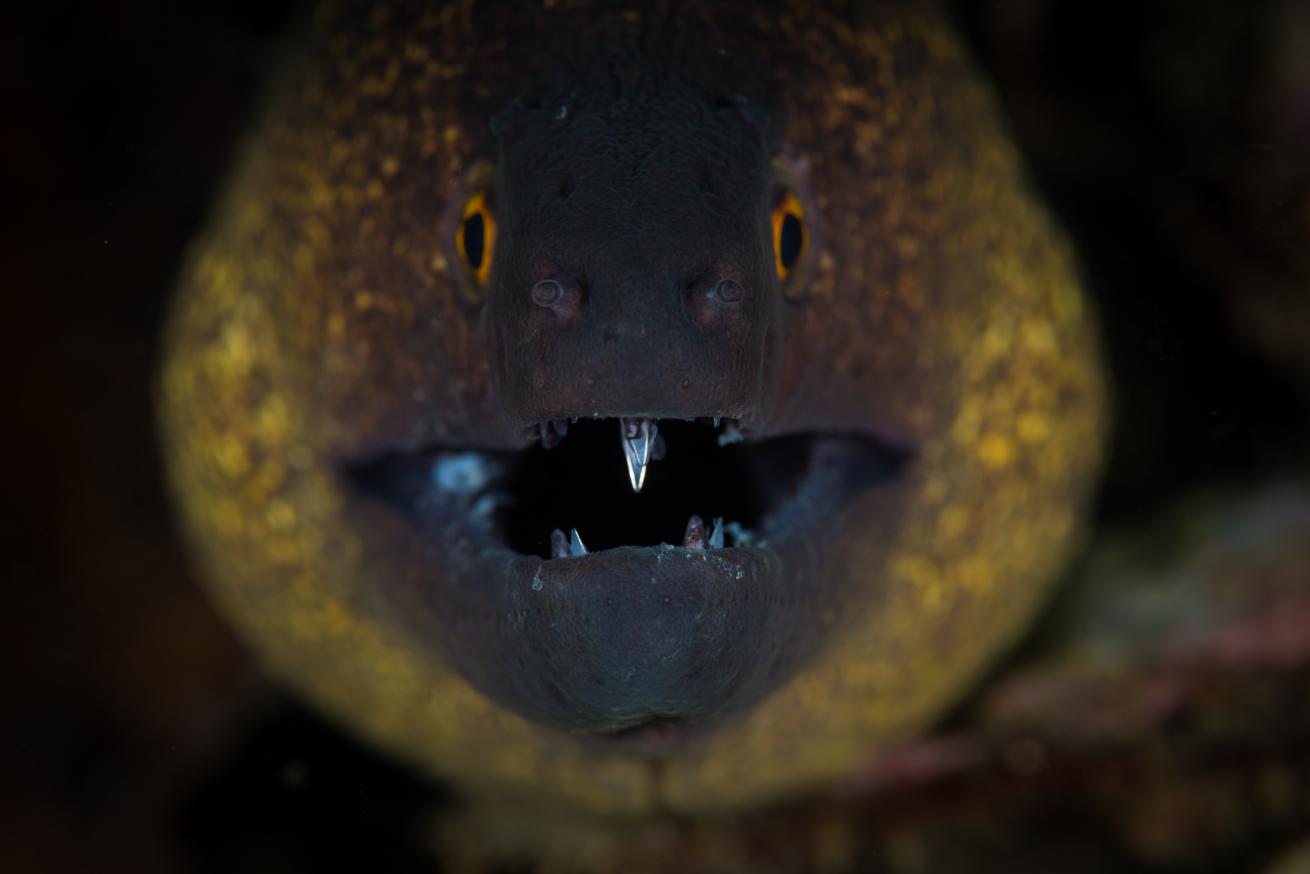
ShutterstockA Yellowmargin moray (G_ymnothorax flavimarginatus_) grins in the Andaman Sea. Morays open and close their mouths to move water through their gills for respiration. This behaviour can often be seen as a threat but this is far from the truth for they are normally very shy creatures and only attack if provoked.
Western Rocky, our first stop, is actually made up of several small islets. Exploring cut-throughs, chasms and crevices is the name of the game here. For the most part, we search for small critters and are rewarded. Unusual nudibranchs, ornate ghost pipefish, blue ribbon eels and an assortment of small crabs and shrimp cover almost every square inch of the rock.
Despite the thickness of my 70-year-young dive buddy's prescription mask, she is adept at spotting other small critters. On one occasion, our guide points out a pair of mating nudibranchs on the wall. I exhibit a moment of chivalry and move aside with a grand gesture, allowing her to photograph them first. While I wait, I shoot some images of a bright orange Midas blenny nearby. Although impressed by the blenny's exceptionally large fangs, I want the coveted nudibranch shot.
After my buddy is done, I move in for a few shots of the romantic pair. However, I can't find them. I search up and down, left and right. I locate several other nudibranchs in the process, but I can't find that particular pair due to the density of life on the wall. Finally, my dive buddy sees my confusion. She grabs me by the shoulder and kindly points me in the direction of the rest of the divers. I try to communicate with hand signals that I am not lost, just looking for the mating nudibranchs. I must come off looking like a raving lunatic (after all, with one hand occupied by a camera, how do you sign "mating nudibranchs"?). She looks at me as if to say, "you poor boy," and grabs me by the arm and escorts me along.
Yes, I suffer from nudibranchitis: the insatiable need to photograph sea slugs. Luckily, my dive buddy understands this affliction. The slopes of Western Rocky are a good place for people who suffer from this same disorder. Although nudibranchs abound here, my favorite encounter at this dive site is with a cuttlefish. In one of the sand channels between the rocks I come across a lone cuttlefish that is curious about the camera, at first. When the strobe goes off, it turns bright red and puts on a threat display, its arms poised like venomous snakes, ready to strike.
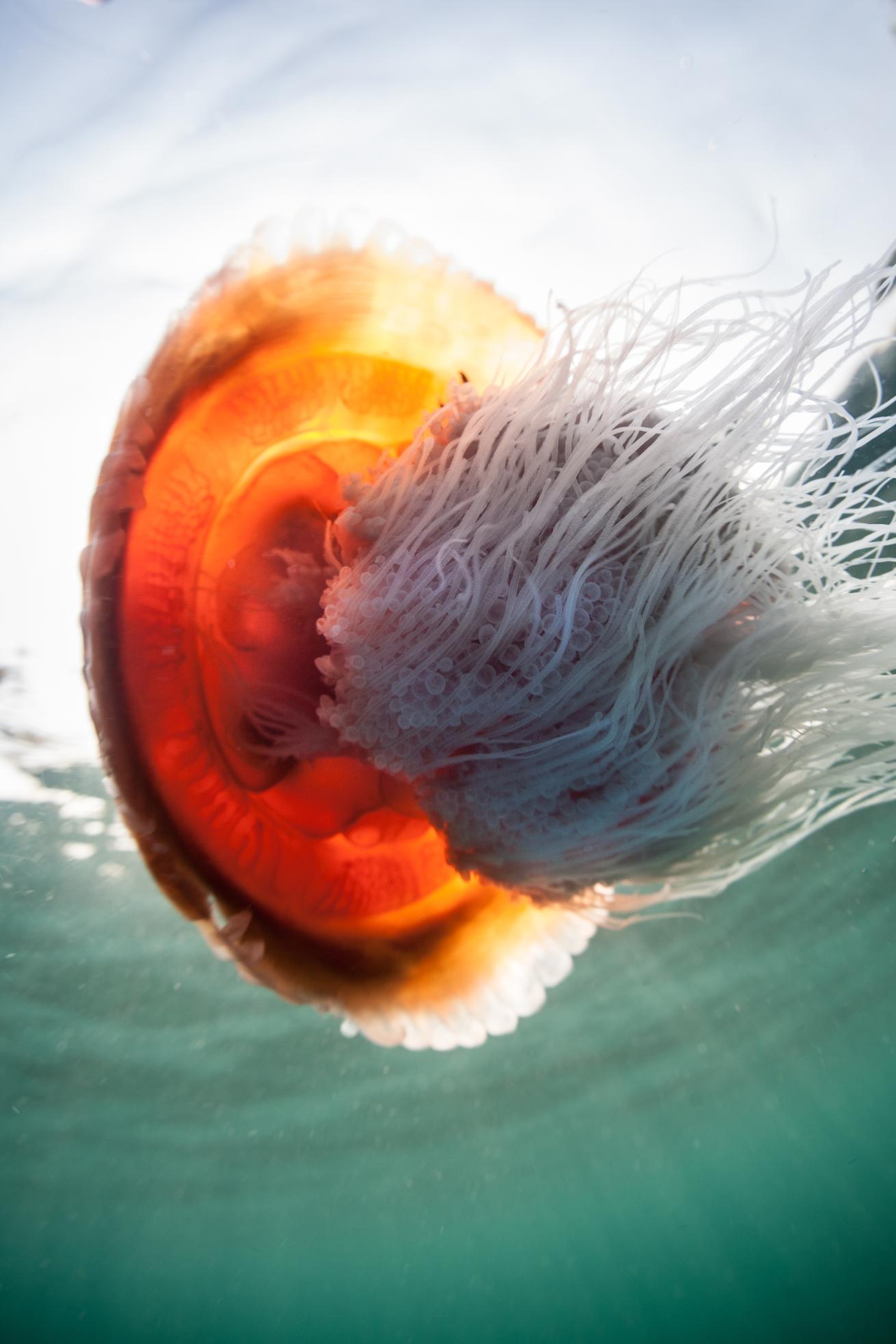
ShutterstockA jellyfish glides by in shallow water in the Andaman Sea. Jellyfish are seemingly becoming more prevalent worldwide as climate change proceeds.
The next day we dive Black Rock, and during our pre-dive briefing we are told about a diver who was "bumped" by a manta the previous week. "What do you mean ‘bumped'?" asks one of the divers a little anxiously. "He was tapped on the head by the manta's wings," replies our guide. "He was a little stunned, but unhurt." There is a momentary silence, and then a cheer goes up from our group: "Yes! I want to be tapped by a manta too!" We gear up, fully anticipating mantas, but we won't be so lucky.
Despite the absence of mantas, we do see interesting little things: Harlequin shrimp, elegant hermit crabs and porcelain crabs. But the most interesting event occurs on the last dive of the day. In the waning hours of light, the large field of magnificent sea anemones retract their many arms and curl in upon themselves for a good night's sleep. Apparently, the resident pixy hawkfish are capable of identifying which anemones have eaten most recently. A small aggregation of them forms near certain anemones and, one at a time, dive into the closing mouth to pick off small morsels of food. Photographing this is a challenge, but witnessing it is amazing.
Close Encounter in the Similan Islands
Thailand's Similan Islands are our next stop. Again, we enter the busy waters filled with dive boats. However, despite the quantity of boats we encounter on the surface, we rarely meet up with other divers underwater. We dive sites like East of Eden--loaded with brilliant soft corals and colorful reef fish--and Sharkfin Reef and Elephant Ear Rock, where gigantic boulders form surreal swim-throughs and canyons. However, it is a site named Twin Peaks at Koh Tachai that provides one of the biggest thrills of our aquatic journey.
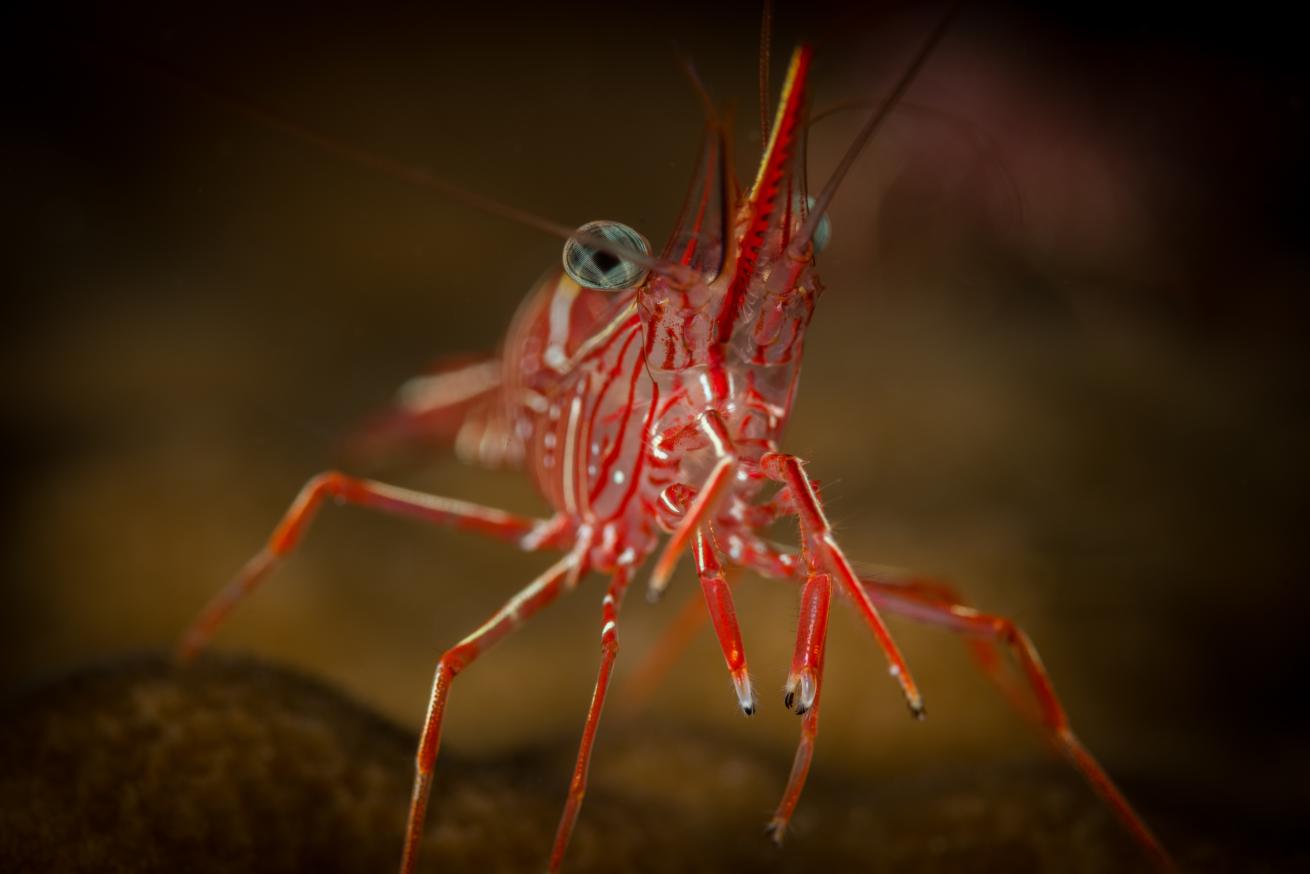
ShutterstockDurban hinge-back shrimp (Rhynchocinetes durbanensis) in the Andaman Sea, Thailand. It is often seen moving around with sudden abrupt stops, hence the name "Dancing Shrimp."
We dive Twin Peaks as a morning dive on our second-to-last day. Halfway into the dive, our guide signals us, pointing feverishly into the distance. Most of us can't tell what he is pointing at, but we know it must be good. Whatever it is, it has already headed in the other direction, into deep water. Fifteen minutes later I've fallen behind the group and am contentedly photographing reef fish when I sense a giant shadow over my shoulder. I look up to see a juvenile whale shark. It appears to be barely moving, but try as I might, I can't keep pace with it. I try yelling through my regulator to the rest of the group, and one at a time they turn to see the 15-foot-long shark. It curiously gazes at the little bubble-blowing creatures that seem so excited to see it. Most of us drain our tanks in a futile attempt to keep up with this little giant.
Back on the boat, looks of contentment reign supreme, as the divers can now check off having seen a creature that has put diving in Thailand on the map. I want to ask how everyone's dive was, but pause and think better of it. I let everyone enjoy the moment, and if someone isn't happy because a 15-foot shark blocked their view of the sun, well, I don't want to hear about it.
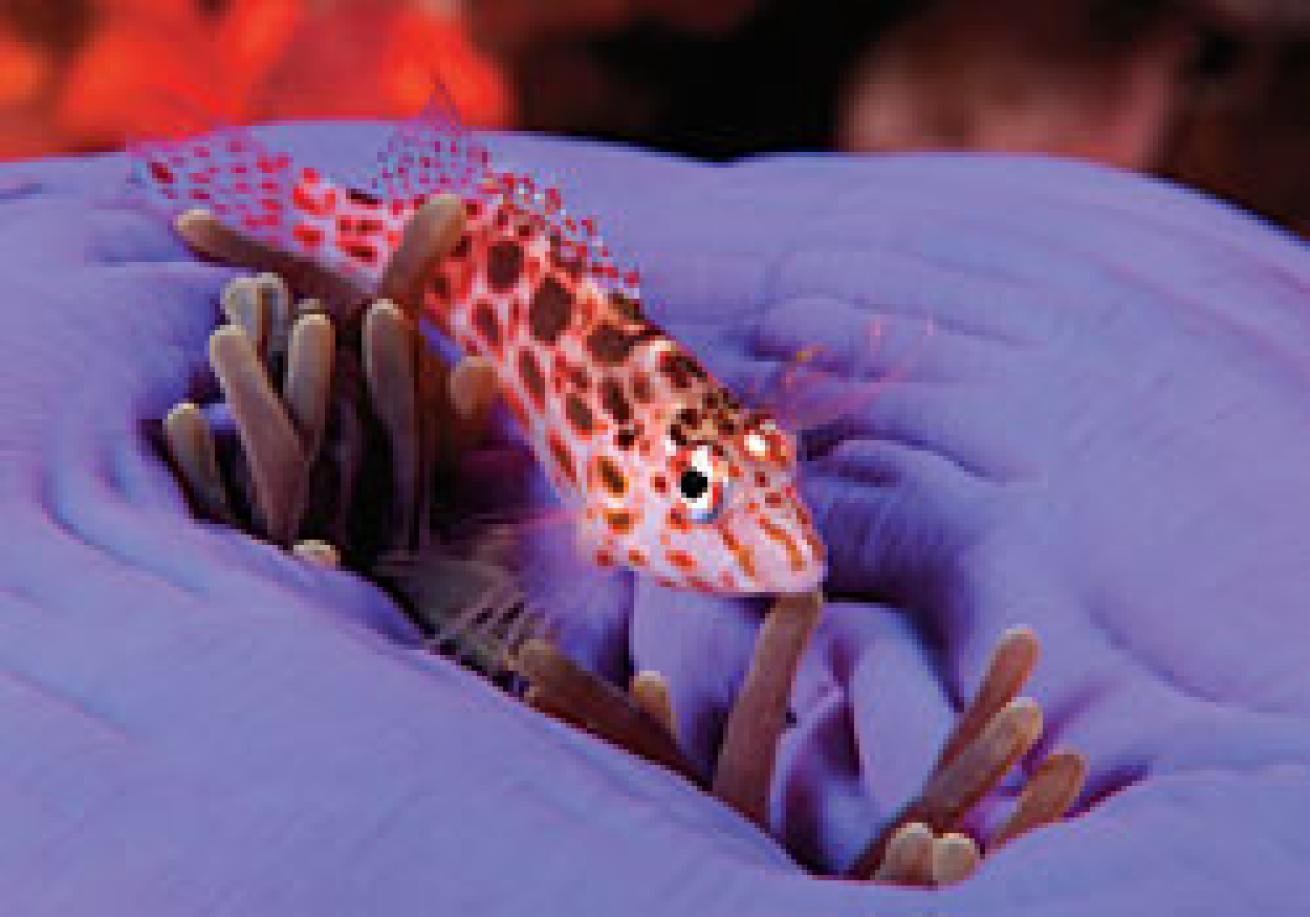
Ethan GordonA pixy hawkfish rests on a sea anemone at Black Rock.
Surface Interval
Chiang Mai
As a diver, I rarely venture inland, but a trip to the city of Chiang Mai, in Thailand's northern highlands, is one worth taking. Just a short flight from Phuket or Bangkok, Chiang Mai was built in 1259--and its original walls can still be seen to this day.
No visitor to Chiang Mai should miss the night bazaar, where vendors lining the main street sell everything from handicrafts to designer knockoffs. Many of Thailand's famed handicrafts--such as woodcarvings, jewelry and parasols--are also manufactured in this region, and you can watch them being made in the many factories that are open to tourists.
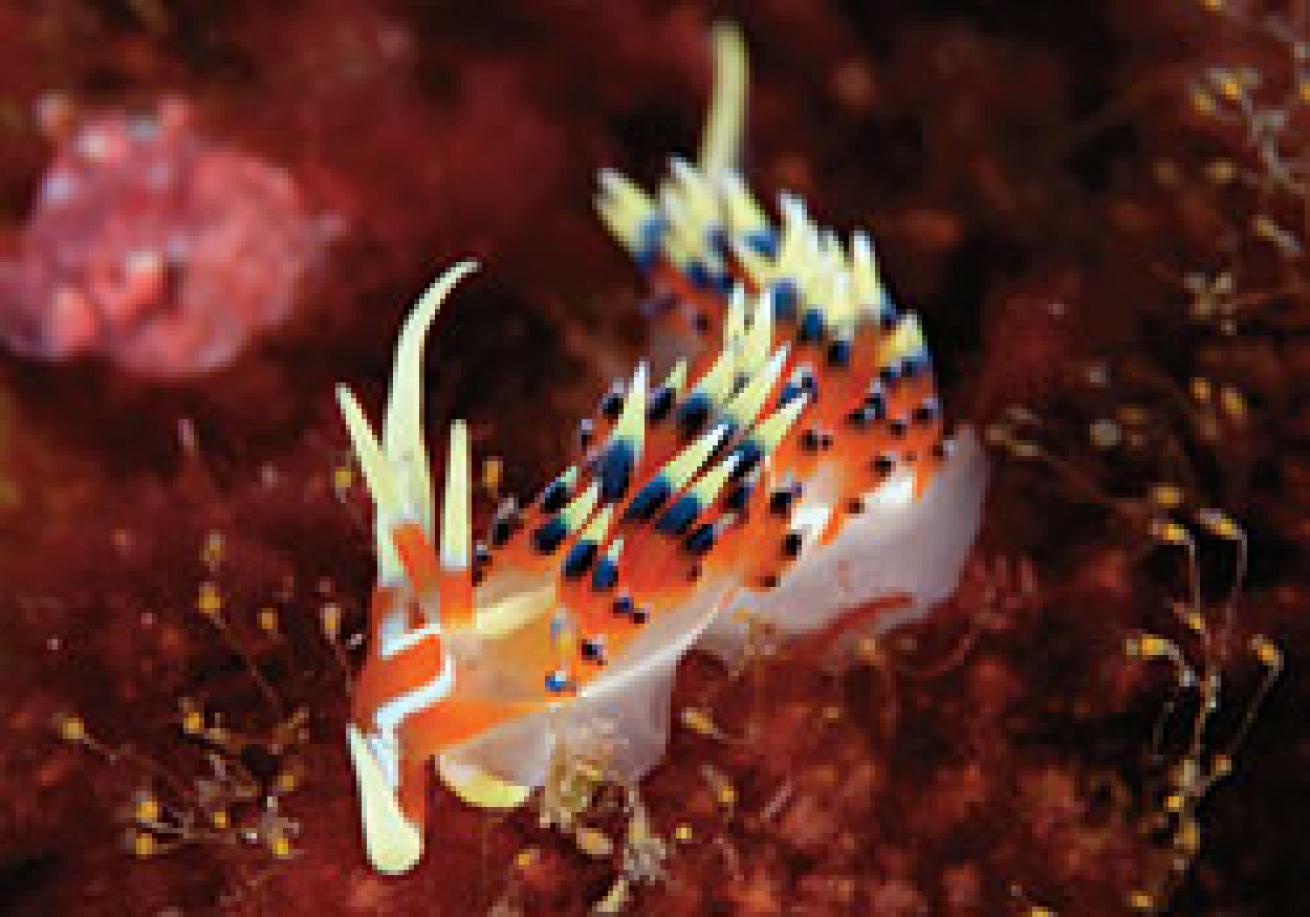
Ethan GordonNudibranchs are found on the slopes of Western Rocky.
Besides shopping, Chiang Mai also offers a range of don't-miss cultural highlights. Elephants are no longer used for foresting, but elephant camps remain in operation so that visitors can get a glimpse into history (not to mention a ride on an elephant's back).
And Wat Prathat Doi Suthep, a Buddhist temple high atop a mountain, is a definite must-see. From here you have commanding views of the valley below. In addition, the temple's gilded architecture is stunning; if possible, visit in the late afternoon for the best light.
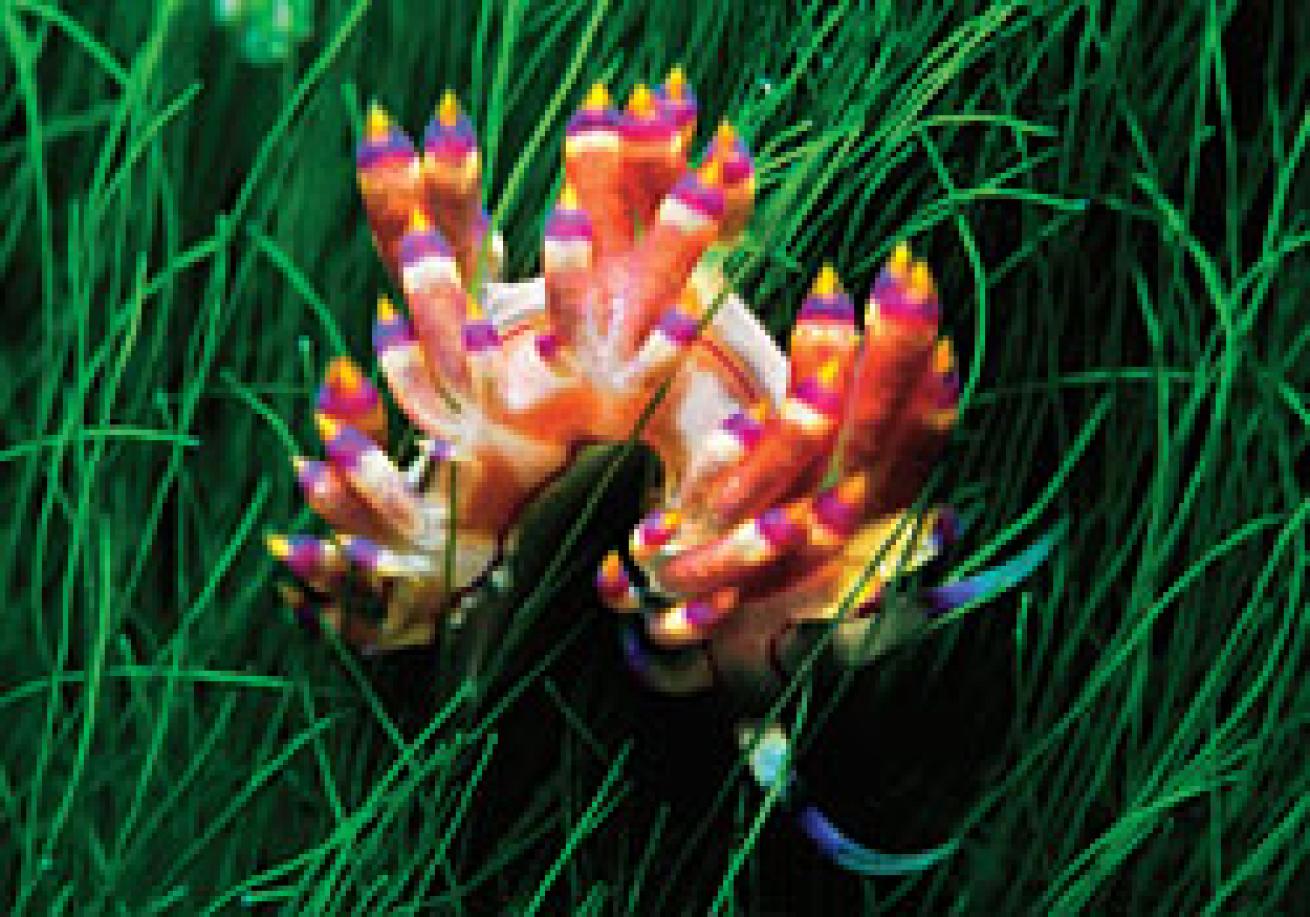
Ethan GordonWe found mating nudibranchs on our trip, too.
Photo Tips
Shoot Thailand Like a Pro
Underwater
Macro critters are guaranteed, so be sure you're equipped for this. However, you never know when a whale shark will show up, so ask your dive guide at which sites you'll have the best chance of spotting one.
Stay close to your guide. Many of the small critters are hard to spot, so you'll need an expert's eyes to help locate that elusive ornate ghost pipefish.
Many dive sites can experience some current, which makes shooting close-ups a bit of a challenge. Steady yourself by locating a barren rock, rest a finger or two on the rock and kick your fins slightly to stay in place in the current. But remember, if you can't get the shot, don't damage the reef trying.
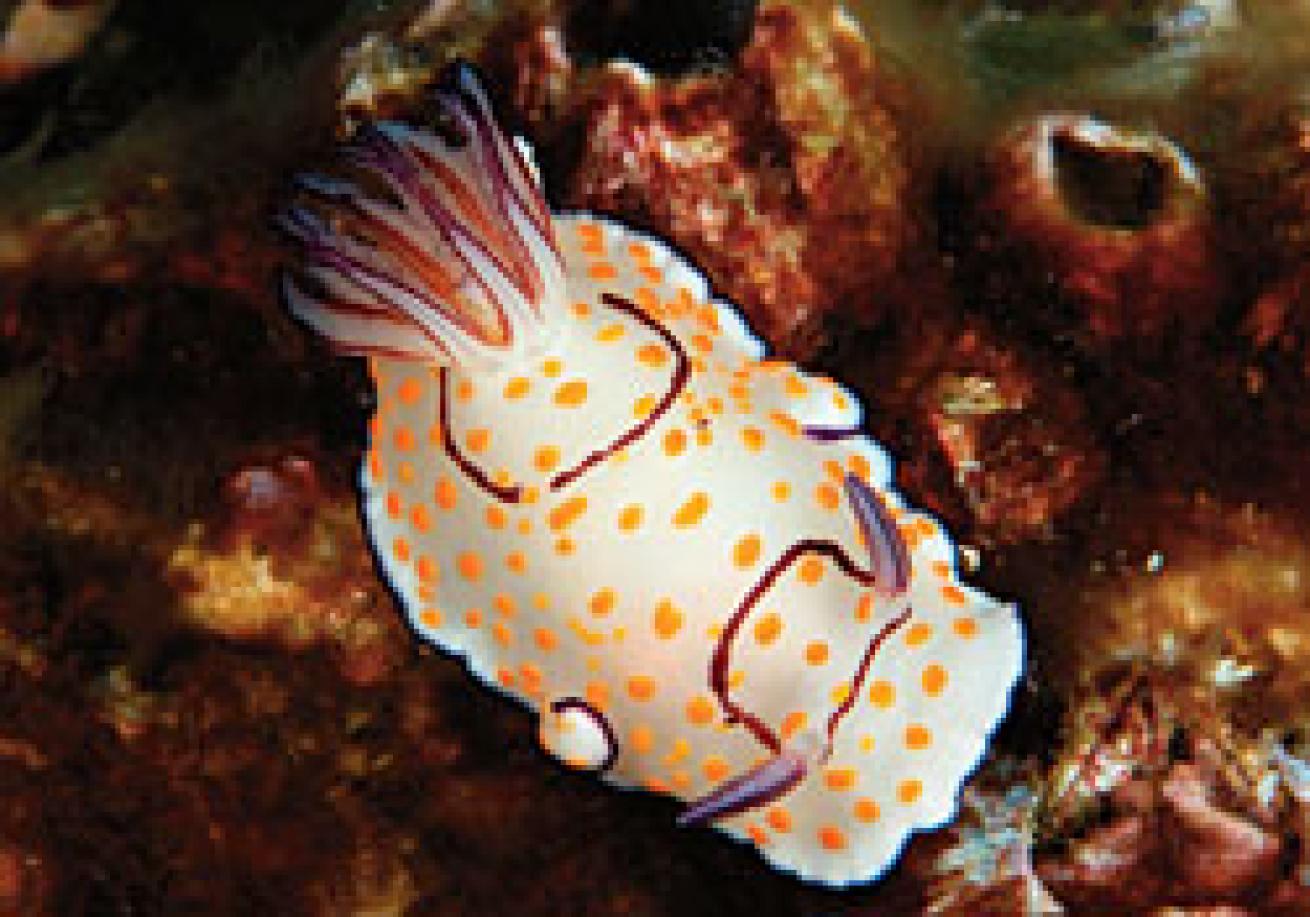
Ethan GordonIf you're looking to add to your nudi portfolio, you've come to the right place.
Topside
Most Buddhist temples are open 24 hours a day. But photographing their gilded surfaces in the midday sun is difficult. Visit the temples in the early morning or late afternoon to get the better light and avoid the crowds. If you can, bring a tripod and set up an after-dark shot, when the temples are illuminated.
To photograph the elephant camps most effectively, you'll want your images to look like they were shot in a rustic location, not at Ringling Brothers. Try to find angles where you can capture images of the elephants with trees in the background — and avoid the tourist viewing stands as a backdrop.
The people of Thailand are very friendly and typically don't mind having their photos taken. I always ask first, but I don't recall anyone ever saying "no." Then, hang out for a while until they relax and resume their normal routines. That is the perfect time for candid shots.
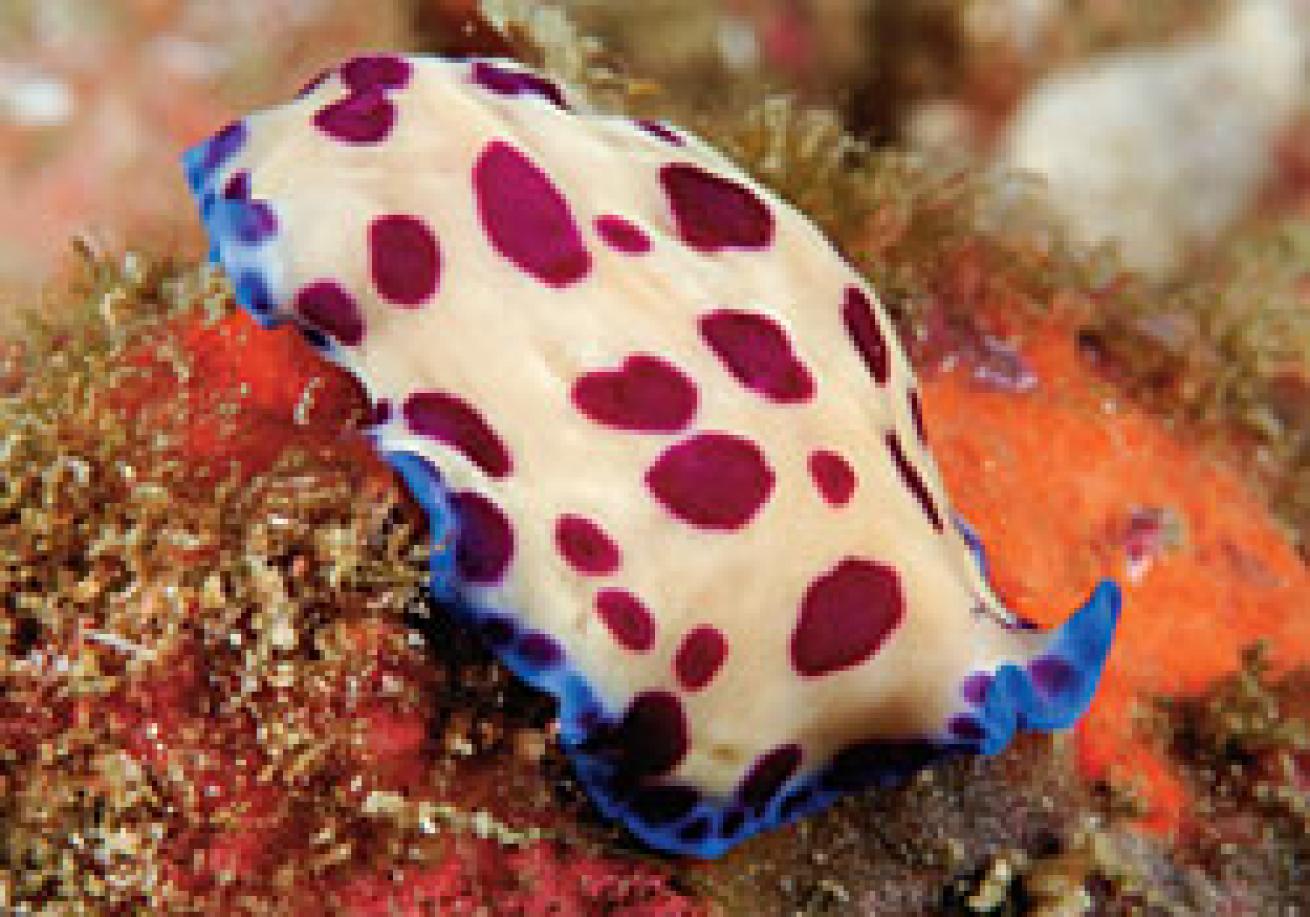
Ethan Gordon
InDepth
Roughly the size of France, Thailand stretches more than 1,100 miles from north to south and covers about 202,000 square miles. It has two coastlines, one along the Andaman Sea and the other along the Gulf of Thailand.
Water Conditions: In the Andaman Sea, water temperatures are usually warm, ranging from 79 to 84 degrees, though it can be quite a bit cooler at depth, especially during March and April. Water clarity varies from less than 20 feet to 150 feet or more, depending on the season. In general, conditions are best beginning in November. Plankton blooms in March and April drop the vis. Most live-aboards stop operating here from June through October, the southwest monsoon season when vis can be excellent but the seas can be rough, especially at exposed sites. In the Gulf of Thailand, water temps are in the low to mid-80s, with the warmest conditions during May and June. Vis is not as good in the gulf because of freshwater runoff, plankton and water circulation. The northeast monsoon blows from November through February stirring up the seas and sediment. February through September is generally the best time for diving, when conditions improve.
To explore this destination by liveaboard, visit the Thailand Aggressor.
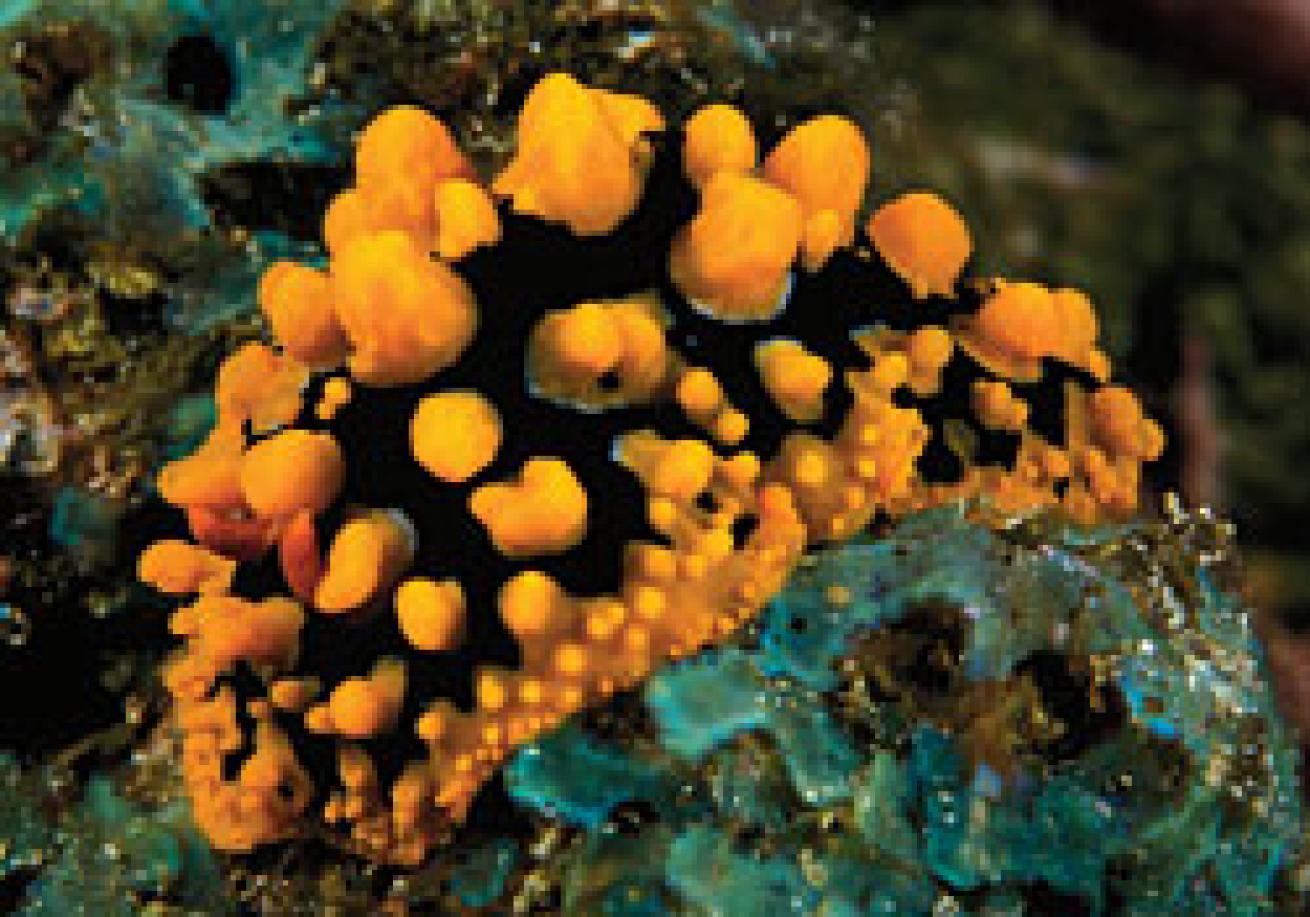
Ethan GordonNudibranchs in Western Rocky
Western Rocky, where we spotted many nudibranchs, is actually made up of several islets. Unusual nudibranchs, ornate ghost pipefish, blue ribbon eels, and an assortment of small crabs and shrimp cover almost every square inch of rock.

Ethan GordonPhotograph of the gilded surfaces in a temple
Photographing the gilded surfaces of temples in midday sun is difficult. Visit the temples in early morning or late afternoon to get better light (and avoid the crowds). If you can, bring a tripod and set up an after-dark shot, when the temples are illuminated.


